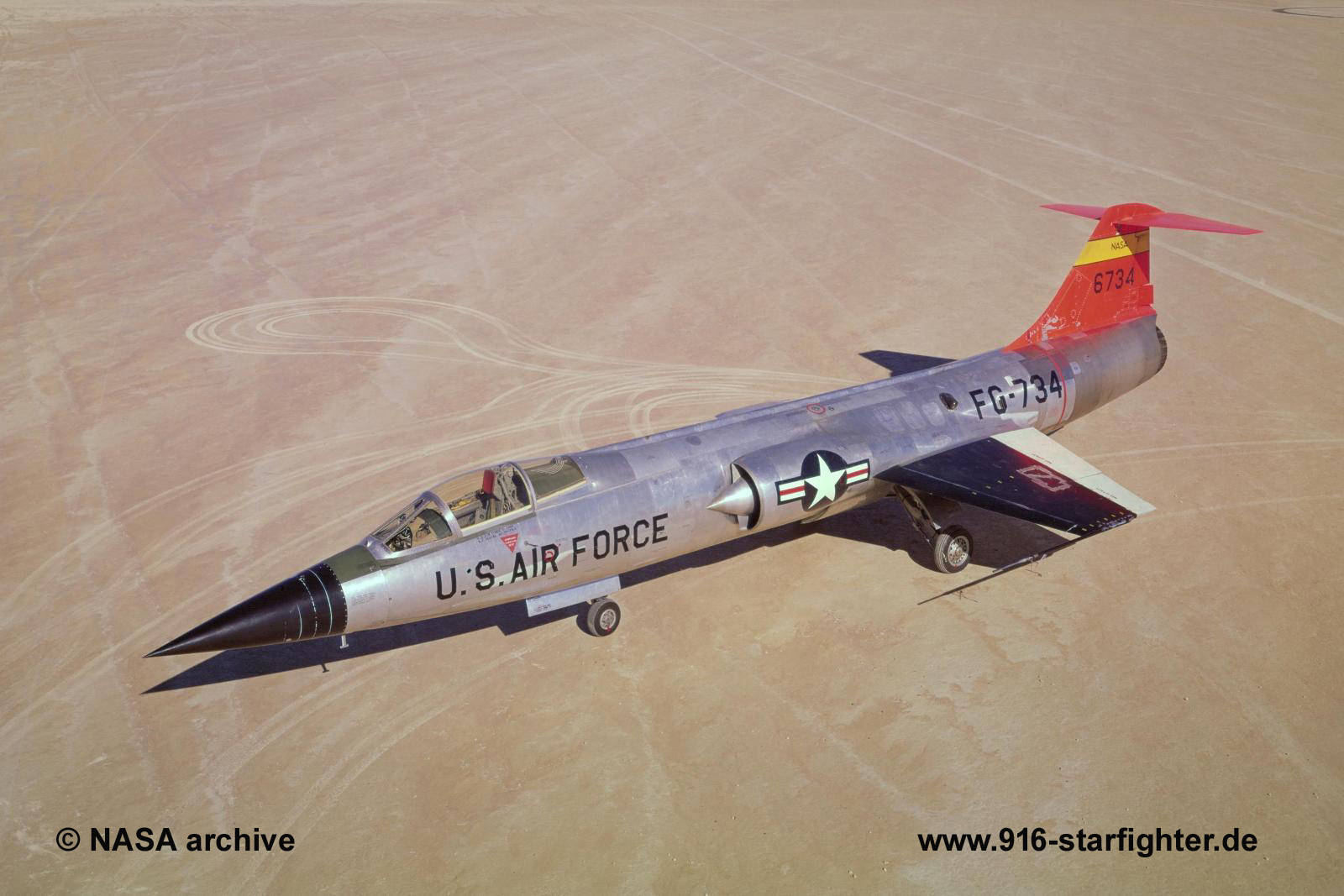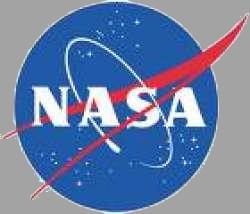
F-104A "FG-734" (56-0734) at NACA HSFS (High Speed Flight Station) program, Dryden 1960
F-104A, construction number 183-1022, model 183-93-02, US serial number 56-0734, built by Lockheed
 1022 accepted by the USAF on May 29, 1957; delivery date June 3, 1957
and loaned by NASA on October 7, 1957 (NACA HSFS (High Speed Flight Station) program, Dryden). Neil Armstrong flew it on January 14, 1958,
Milt Thomson flew it May 28, 1959. On January 10, 1961 "NASA 734" (FG-734/6734) was transferred back to the USAF and was flown over to Palmdale
from Dryden by John McKay. At Palmdale it received the latest upgrades (seen January 25, 1962) and was converted to QF-104A standard
which was finalized on May 14, 1962. On June 14, 1962 it was flown from Palmdale to Eglin. There it was used as drone from that moment on
by the 3205 Drone Squadron. During the QF drone missions it encountered a few accidents. Coded QFG-734 had a first a barrier engagement
at Eglin on August 10, 1962 (drone flight), then again a barrier engagement (drone flight) on September 7, 1962
the third barrier engagement in 1962 took place on September 12, but then the aircraft sustained major damage while it collapsed
it was immediately repaired at Eglin AFB and received modifications towards a JQF-104A standard in October 1962. Conversion finished October 16, 1962
lateron it went back in drone-business and again encountered a barrier engagement on February 6, 1963
again it sustained damage but this could be repaired soon; on August 1, 1963 the aircraft was finally shot down during a drone-mission by a BOMARC missile after 114 drone flights.
The Air Force lent the NACA a second Starfighter, serial number 56-734, in October 1957.
With NACA followed a major program to obtain boundary-layer-transition measurements in full-scale flight on this aircraft.
To obtain the desired data, HSFS personnel installed pressure instrumentation and temperature gauges on the outside surface of the left-hand wing.
The leading edge flaps were deactivated and a fiberglass glove installed to maintain the original contour and smooth surface of the wing.
copyright © NASA archive
1022 accepted by the USAF on May 29, 1957; delivery date June 3, 1957
and loaned by NASA on October 7, 1957 (NACA HSFS (High Speed Flight Station) program, Dryden). Neil Armstrong flew it on January 14, 1958,
Milt Thomson flew it May 28, 1959. On January 10, 1961 "NASA 734" (FG-734/6734) was transferred back to the USAF and was flown over to Palmdale
from Dryden by John McKay. At Palmdale it received the latest upgrades (seen January 25, 1962) and was converted to QF-104A standard
which was finalized on May 14, 1962. On June 14, 1962 it was flown from Palmdale to Eglin. There it was used as drone from that moment on
by the 3205 Drone Squadron. During the QF drone missions it encountered a few accidents. Coded QFG-734 had a first a barrier engagement
at Eglin on August 10, 1962 (drone flight), then again a barrier engagement (drone flight) on September 7, 1962
the third barrier engagement in 1962 took place on September 12, but then the aircraft sustained major damage while it collapsed
it was immediately repaired at Eglin AFB and received modifications towards a JQF-104A standard in October 1962. Conversion finished October 16, 1962
lateron it went back in drone-business and again encountered a barrier engagement on February 6, 1963
again it sustained damage but this could be repaired soon; on August 1, 1963 the aircraft was finally shot down during a drone-mission by a BOMARC missile after 114 drone flights.
The Air Force lent the NACA a second Starfighter, serial number 56-734, in October 1957.
With NACA followed a major program to obtain boundary-layer-transition measurements in full-scale flight on this aircraft.
To obtain the desired data, HSFS personnel installed pressure instrumentation and temperature gauges on the outside surface of the left-hand wing.
The leading edge flaps were deactivated and a fiberglass glove installed to maintain the original contour and smooth surface of the wing.
copyright © NASA archive



 1022 accepted by the USAF on May 29, 1957; delivery date June 3, 1957
and loaned by NASA on October 7, 1957 (NACA HSFS (High Speed Flight Station) program, Dryden). Neil Armstrong flew it on January 14, 1958,
Milt Thomson flew it May 28, 1959. On January 10, 1961 "NASA 734" (FG-734/6734) was transferred back to the USAF and was flown over to Palmdale
from Dryden by John McKay. At Palmdale it received the latest upgrades (seen January 25, 1962) and was converted to QF-104A standard
which was finalized on May 14, 1962. On June 14, 1962 it was flown from Palmdale to Eglin. There it was used as drone from that moment on
by the 3205 Drone Squadron. During the QF drone missions it encountered a few accidents. Coded QFG-734 had a first a barrier engagement
at Eglin on August 10, 1962 (drone flight), then again a barrier engagement (drone flight) on September 7, 1962
the third barrier engagement in 1962 took place on September 12, but then the aircraft sustained major damage while it collapsed
it was immediately repaired at Eglin AFB and received modifications towards a JQF-104A standard in October 1962. Conversion finished October 16, 1962
lateron it went back in drone-business and again encountered a barrier engagement on February 6, 1963
again it sustained damage but this could be repaired soon; on August 1, 1963 the aircraft was finally shot down during a drone-mission by a BOMARC missile after 114 drone flights.
The Air Force lent the NACA a second Starfighter, serial number 56-734, in October 1957.
With NACA followed a major program to obtain boundary-layer-transition measurements in full-scale flight on this aircraft.
To obtain the desired data, HSFS personnel installed pressure instrumentation and temperature gauges on the outside surface of the left-hand wing.
The leading edge flaps were deactivated and a fiberglass glove installed to maintain the original contour and smooth surface of the wing.
copyright © NASA archive
1022 accepted by the USAF on May 29, 1957; delivery date June 3, 1957
and loaned by NASA on October 7, 1957 (NACA HSFS (High Speed Flight Station) program, Dryden). Neil Armstrong flew it on January 14, 1958,
Milt Thomson flew it May 28, 1959. On January 10, 1961 "NASA 734" (FG-734/6734) was transferred back to the USAF and was flown over to Palmdale
from Dryden by John McKay. At Palmdale it received the latest upgrades (seen January 25, 1962) and was converted to QF-104A standard
which was finalized on May 14, 1962. On June 14, 1962 it was flown from Palmdale to Eglin. There it was used as drone from that moment on
by the 3205 Drone Squadron. During the QF drone missions it encountered a few accidents. Coded QFG-734 had a first a barrier engagement
at Eglin on August 10, 1962 (drone flight), then again a barrier engagement (drone flight) on September 7, 1962
the third barrier engagement in 1962 took place on September 12, but then the aircraft sustained major damage while it collapsed
it was immediately repaired at Eglin AFB and received modifications towards a JQF-104A standard in October 1962. Conversion finished October 16, 1962
lateron it went back in drone-business and again encountered a barrier engagement on February 6, 1963
again it sustained damage but this could be repaired soon; on August 1, 1963 the aircraft was finally shot down during a drone-mission by a BOMARC missile after 114 drone flights.
The Air Force lent the NACA a second Starfighter, serial number 56-734, in October 1957.
With NACA followed a major program to obtain boundary-layer-transition measurements in full-scale flight on this aircraft.
To obtain the desired data, HSFS personnel installed pressure instrumentation and temperature gauges on the outside surface of the left-hand wing.
The leading edge flaps were deactivated and a fiberglass glove installed to maintain the original contour and smooth surface of the wing.
copyright © NASA archive


